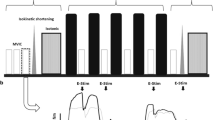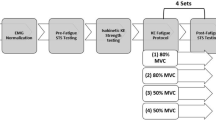Abstract
The purpose of this study was to determine the influence of load compliance on the time to failure and rate of change in electromyographic (EMG) activity when the knee extensor muscles performed fatiguing contractions against submaximal loads. The low-compliance condition required the subject to exert a force against a rigid restraint (force control), whereas the high-compliance condition involved maintaining the knee joint angle while supporting an equivalent inertial load (position control). Both contractions were sustained for as long as possible. Each subject exerted a similar net torque about the knee joint during the force and position tasks; the target force corresponded to a force at the ankle equal to 20% of the maximal voluntary contraction (MVC) force. Thirteen healthy adults (25 ± 7 year) participated in the study. MVC forces before the force and position tasks were similar (189 ± 40 N vs. 179 ± 43 N, P = 0.4), and the target force was 36 ± 8 N. The time to task failure was longer for the force task (224 ± 114 s) than for the position task (110 ± 36 s, P < 0.05), but MVC force declined to a similar level immediately after task failure for the two tasks (−31 ± 16%). The briefer time to failure for the position task was accompanied by greater rates of increase in agonist EMG amplitude and the pressor response. Coactivation ratios, in contrast, were similar for the two tasks and did not contribute to task differences in time to failure. These findings indicate that it was more difficult to sustain a submaximal contraction with the knee extensor muscles when the task required position control, despite comparable net muscle torques for the low- and high-compliance tasks.






Similar content being viewed by others
References
Akazawa K, Milner TE, Stein RB (1983) Modulation of reflex EMG and stiffness in response to stretch of human wrist extensor muscle. J Neurophysiol 49:16–27
Alam M, Smirk F (1937) Observation in man upon blood pressure raising reflex arising from the voluntary muscles. J Physiol 89:372–383
Baratta R, Solomonow M, Zhou BH, Letson D, Chuinard R, D’Ambrosia R (1988) Muscular coactivation: the role of the antagonist musculature in maintaining knee stability. Am J Sports Med 16:113–122
Baudry S, Jordan K, Enoka RM (2008) Presynaptic inhibition of Ia afferents in humans changes during fatiguing contractions. Soc Neurosci Abstr # 2008-S-106367
Bigland-Ritchie B, Furbush F, Woods JJ (1986) Fatigue of intermittent submaximal voluntary contractions: central and peripheral factors. J Appl Physiol 61:421–429
Borg GAV (1982) Psychophysical bases of perceived exertion. Med Sci Sports Exerc 14:377–381
Butler JE, Taylor JL, Gandevia SC (2003) Responses of human motoneurones to corticospinal stimulation during maximal voluntary contractions and ischemia. J Neurosci 23:10224–10230
Calvin WH, Stevens CF (1968) Synaptic noise and other sources of randomness in motoneuron interspike intervals. J Neurophysiol 31:574–587
Carson RG, Riek S, Shahbazpour N (2002) Central and peripheral mediation of human force sensation following eccentric or concentric contractions. J Physiol 539:903–912
De Serres SJ, Bennett DJ, Stein RB (2002) Stretch reflex gain in cat triceps surae muscles with compliant loads. J Physiol 545:1027–1040
Duchateau J, Balestra C, Carpentier A, Hainaut K (2002) Reflex regulation during sustained and intermittent submaximal contractions in humans. J Physiol 541:959–967
Enoka RM, Duchateau J (2008) Muscle fatigue: what, why and how it influences muscle function. J Physiol 586:11–23
Fisher WJ, White MJ (1999) Training-induced adaptations in the central command and peripheral reflex components of the pressor response to isometric exercise of the human triceps surae. J Physiol 520:621–628
Gandevia SC, Hobbs SF (1990) Cardiovascular responses to static exercise in man: central and reflex contributions. J Physiol 430:105–117
Garland SJ (1991) Role of small diameter afferents in reflex inhibition during human muscle fatigue. J Physiol 435:547–558
Green JM, McLester JR, Crews TR, Wickwire PJ, Pritchett RC, Lomax RG (2006) RPE association with lactate and heart rate during high-intensity interval cycling. Med Sci Sports Exerc 38:167–172
Hunter SK, Ryan DL, Ortega JD, Enoka RM (2002) Task differences with the same load alter the endurance time of submaximal fatiguing contractions in humans. J Neurophysiol 88:3087–3096
Hunter SK, Yoon T, Farinella J, Griffith J, Ng AV (2008) Time to task failure and muscle activation vary with load type for a submaximal fatiguing contraction with the lower leg. J Appl Physiol 105:463–472
Jacobs PL, Klose KJ, Guest R, Needham-Stropshire B, Broton JG, Green BA (1997) Relationships of oxygen uptake, heart rate, and ratings of perceived exertion in persons with paraplegia during functional neuromuscular stimulation assisted ambulation. Spinal Cord 35:292–298
Justice JN, Rudroff T, Matthews SD, Enoka RM (2008) Time to failure and muscle activation differ with load type during fatiguing contractions with the knee extensor muscles. Soc Neurosci Abstr # 617.2
Kellis E (1998) Quantification of quadriceps and hamstring antagonist activity. Sports Med 25:37–62
Klass M, Lévénez M, Enoka RM, Duchateau J (2008) Spinal mechanisms contribute to differences in the time to failure of submaximal fatiguing contractions performed with different loads. J Neurophysiol 99:1096–1104
Lewis JE, Nash MS, Hamm LF, Martins SC, Groah LS (2007) The relationship between perceived exertion and physiologic indicators of stress during graded arm exercise in persons with spinal cord injuries. Arch Phys Med Rehabil 88:1205–1211
MacDonald MJ, Shoemaker JK, Tschakovsky ME, Hughson RL (1998) Alveolar oxygen uptake and femoral artery blood flow dynamics in upright and supine leg exercise in humans. J Appl Physiol 85:1622–1628
Macefield VG, Gandevia SC, Bigland-Ritchie B, Gorman RB, Burke D (1993) The firing rates of human motoneurons voluntarily activated in the absence of muscle afferent. J Physiol 471:429–443
Maluf KS, Shinohara M, Stephenson JL, Enoka RM (2005) Muscle activation and time to task failure differ with load type and contraction intensity for a human hand muscle. Exp Brain Res 167:165–177
Matthews PB (1996) Relationship of firing intervals of human motor units to the trajectory of post-spike after-hyperpolarization and synaptic noise. J Physiol 492:597–628
Mottram CJ, Jakobi JM, Semmler JG, Enoka RM (2005) Motor unit activity differs with load type during fatiguing contractions. J Neurophysiol 93:1381–1392
Mottram CJ, Hunter SK, Rochette L, Anderson MK, Enoka RM (2006) Time to task failure varies with the gain of the feedback signal for women, but not for men. Exp Brain Res 174:575–587
Negro F, Holobar A, Farina D (2009) Fluctuations in isometric muscle force can be described by one linear projection of low-frequency components of motor unit discharge rates. J Physiol 587:5925–5938
Neto OP, Christou EA (2010) Rectification of the EMG signal impairs the identification of oscillatory input to the muscle. J Neurophysiol. (in press)
Noble BJ, Borg GA, Jacobs I, Ceci R, Kaiser P (1983) A category-ratio perceived exertion scale: relationship to blood and muscle lactates and heart rate. Med Sci Sports Exerc 15:523–528
Rainoldi A, Melchiorri G, Caruso I (2004) A method for positioning electrodes during surface EMG recordings in lower limb muscles. J Neurosci Methods 134:37–43
Rainoldi A, Falla D, Mellor R, Bennell K, Hodges P (2007) Myoelectric manifestations of fatigue in vastus lateralis, medialis obliquus and medialis longus muscles. J Electromyogr Kinesiol 18:1032–1037
Riley ZA, Terry ME, Mendez-Villanueva A, Litsey JC, Enoka RM (2008) Motor unit recruitment and bursts of activity in the surface electromyogram during a sustained contraction. Muscle Nerve 37:745–753
Rochette L, Hunter SK, Place N, Lepers R (2003) Activation varies among the knee extensor muscles during a submaximal fatiguing contraction in the seated and supine postures. J Appl Physiol 95:1515–1522
Rowell LB (1993) Human cardiovascular control. Oxford, New York
Rowell LB, O’Leary DS (1990) Reflex control of the circulation during exercise: chemoreflexes and mechanoreflexes. J Appl Physiol 69:407–418
Rudroff T, Poston B, Shin IS, Bojsen-Møller J, Enoka RM (2005) Net excitation of the motor unit pool varies with load type during fatiguing contractions. Muscle Nerve 31:78–87
Rudroff T, Barry BK, Stone AL, Barry CJ, Enoka RM (2007a) Accessory muscle activity contributes to the variation in time to task failure for different arm postures and loads. J Appl Physiol 102:1000–1006
Rudroff T, Christou EA, Poston B, Bojsen-Møller J, Enoka RM (2007b) Time to failure of a sustained contraction is predicted by target torque and initial electromyographic bursts in elbow flexor muscles. Muscle Nerve 35:657–666
Rudroff T, Justice J, Matthews S, Enoka RM (2008) Differences in time to failure are not explained by the work performed by the elbow flexor muscles. Eur Congr Sports Sci Abstr # 514, Estoril, Portugal
Rudroff T, Jordan K, Enoka JA, Matthews SD, Baudry S, Enoka RM (2009) Discharge of biceps brachii motor units is modulated by load compliance and forearm posture. Exp Brain Res. doi: 10.1007/s00221-009-2116-7
Seals DR (1989) Influence of muscle mass on sympathetic neural activation during isometric exercise. J Appl Physiol 67:1801–1806
Seals DR (1993) Influence of active muscle mass on sympathetic nerve discharge during isometric contractions in humans. J Appl Physiol 75:1426–1431
Smith A (1981) The coactivation of antagonist muscles. Can J Physiol Pharmacol 59:733–747
Solomonow M, D’Ambrosia R (1991) Neural reflex arcs and muscle control of stability. In: Scott W (ed) Ligament and extensor mechanism injuries of the knee. Mosby, St Louis, pp 389–400
Windhorst U, Kirmayer D, Soibelman F, Misri A, Rose R (1997) Effects of neurochemically excited group III–IV muscle afferents on motoneuron after hyperpolarization. Neuroscience 76:915–929
Acknowledgments
The work was supported by an award (NS043275) from the National Institute of Neurological Disorders and Stroke (to RME). We thank Mike Pont for building the experimental setup, Jakob Lund Dideriksen and Martin Bækgaard for assistance with Matlab programming, Evangelos A. Christou and Joel Enoka for analyzing EMG frequency data, and Mark Jesunathadas and Matthew Holmes for comments on a draft of the manuscript.
Author information
Authors and Affiliations
Corresponding author
Rights and permissions
About this article
Cite this article
Rudroff, T., Justice, J.N., Matthews, S. et al. Muscle activity differs with load compliance during fatiguing contractions with the knee extensor muscles. Exp Brain Res 203, 307–316 (2010). https://doi.org/10.1007/s00221-010-2233-3
Received:
Accepted:
Published:
Issue Date:
DOI: https://doi.org/10.1007/s00221-010-2233-3




